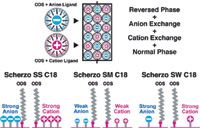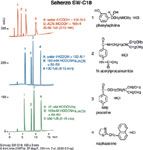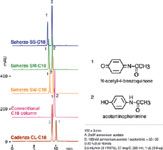The Scherzo Family Columns Effectively Separate Pharmaceutical Compounds
Pharmaceutical compounds are often difficult to analyze on C18 columns alone because they may be charged or have very similar structures. Imtakt Corporation has introduced a family of multimode columns that are able to overcome these separation challenges: Scherzo SS-C18, Scherzo SM-C18, and Scherzo SW-C18, containing C18, anion, and cation ligands.
Pharmaceutical compounds are often difficult to analyze on C18 columns alone because they may be charged or have very similar structures. Imtakt Corporation has introduced a family of multimode columns that are able to overcome these separation challenges: Scherzo SS-C18, Scherzo SM-C18, and Scherzo SW-C18, containing C18, anion, and cation ligands. The SS-C18 contains a large amount of strong ionic ligands, the SW-C18 contains a small amount of strong ionic ligands, and the SM-C18 contains a medium amount of weak ionic ligands (see Figure 1). These multimode columns can separate the charged pharmaceutical compounds phenylephrine, N-acetylprocainamide, procaine, and naphazoline, as well as the very similar acetaminophen and N-acetyl-4-benzoquinoneimine.

Figure 1: Scherzo family of multi-mode columns.
Experimental
All data was generated with a semi-micro HPLC system equipped with UV detection. Separation of phenylephrine, N-acetylprocainamide, procaine, and naphazoline was accomplished with Scherzo SW-C18 of dimensions 150 × 3.0 mm (see Figure 2). This separation was accomplished with three different gradients. All three separations were done at 37 °C and detection occurred at 260 nm.

Figure 2: Separation of basic pharmaceutical compounds.
Separation of acetaminophen and its metabolite NAPQI was accomplished with Unison UK-C18, Cadenza CL-C18, Scherzo SW-C18, Scherzo SM-C18, and Scherzo SS-C18, all of dimensions 150 × 3 mm (see Figure 3). The separation was a gradient elution. Detection occurred at 260 nm and column temperature was 37 °C.

Figure 3: Separation of acetaminophen and NAPQI.
Results and Discussion
Separation of acetaminophen and its metabolite NAPQI was accomplished with Unison UK-C18, Cadenza CL-C18, Scherzo SW-C18, Scherzo SM-C18, and Scherzo SS-C18, all of dimensions 150 × 3 mm (see Figure 3). The separation was a gradient elution. Detection occurred at 260 nm and column temperature was 37 °C.. The development of the Scherzo family columns is an important advancement in HPLC technology that can help to improve separations in the pharmaceutical field.
Imtakt USA
6703 Germantown Avenue, Suite 240, Philadelphia, PA 19119
tel. (888) 456-HPLC, (215) 665-8902, fax (501) 646-3497
Website: www.imtaktusa.com; Email: info@imtaktusa.com

SEC-MALS of Antibody Therapeutics—A Robust Method for In-Depth Sample Characterization
June 1st 2022Monoclonal antibodies (mAbs) are effective therapeutics for cancers, auto-immune diseases, viral infections, and other diseases. Recent developments in antibody therapeutics aim to add more specific binding regions (bi- and multi-specificity) to increase their effectiveness and/or to downsize the molecule to the specific binding regions (for example, scFv or Fab fragment) to achieve better penetration of the tissue. As the molecule gets more complex, the possible high and low molecular weight (H/LMW) impurities become more complex, too. In order to accurately analyze the various species, more advanced detection than ultraviolet (UV) is required to characterize a mAb sample.















